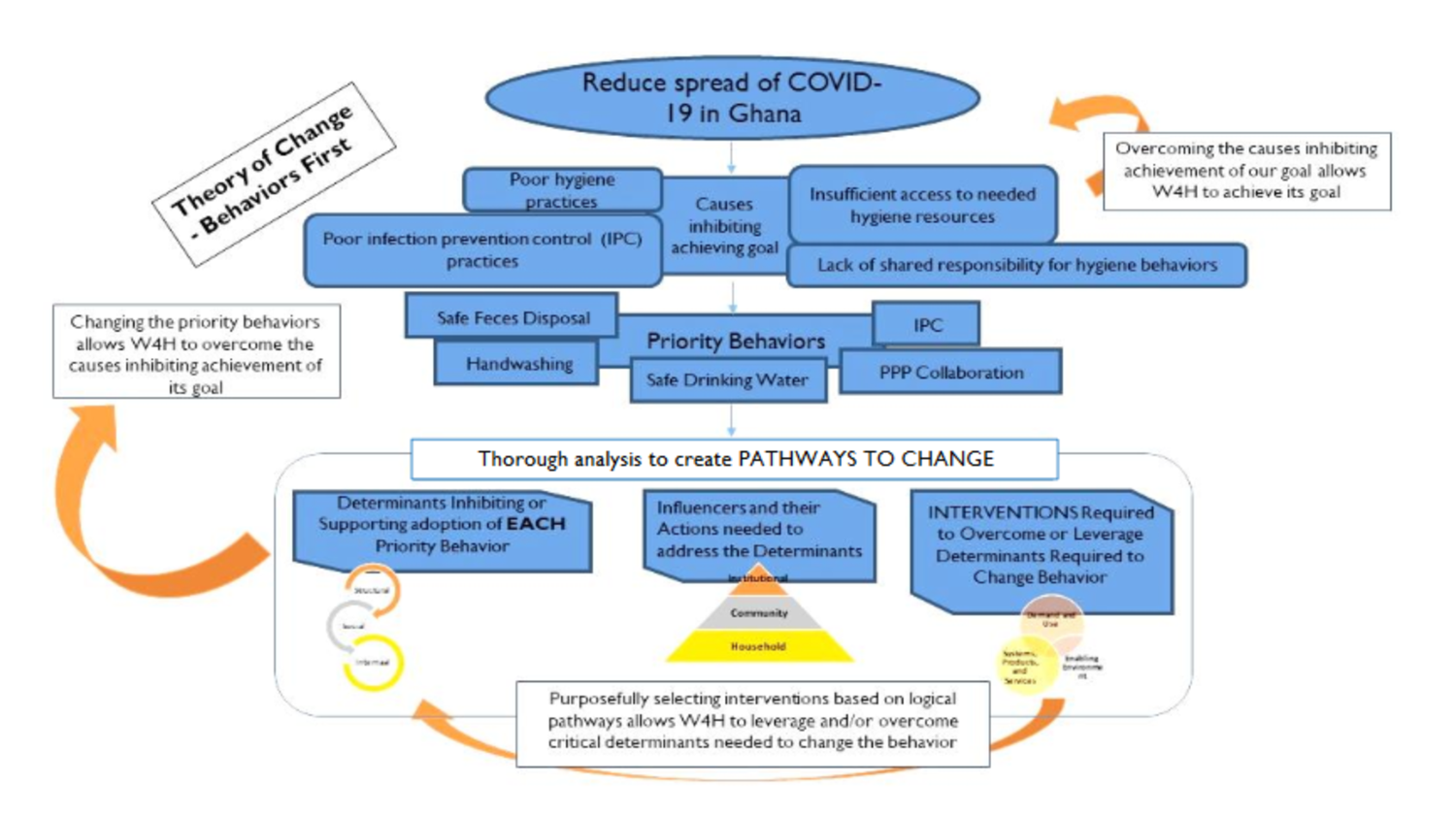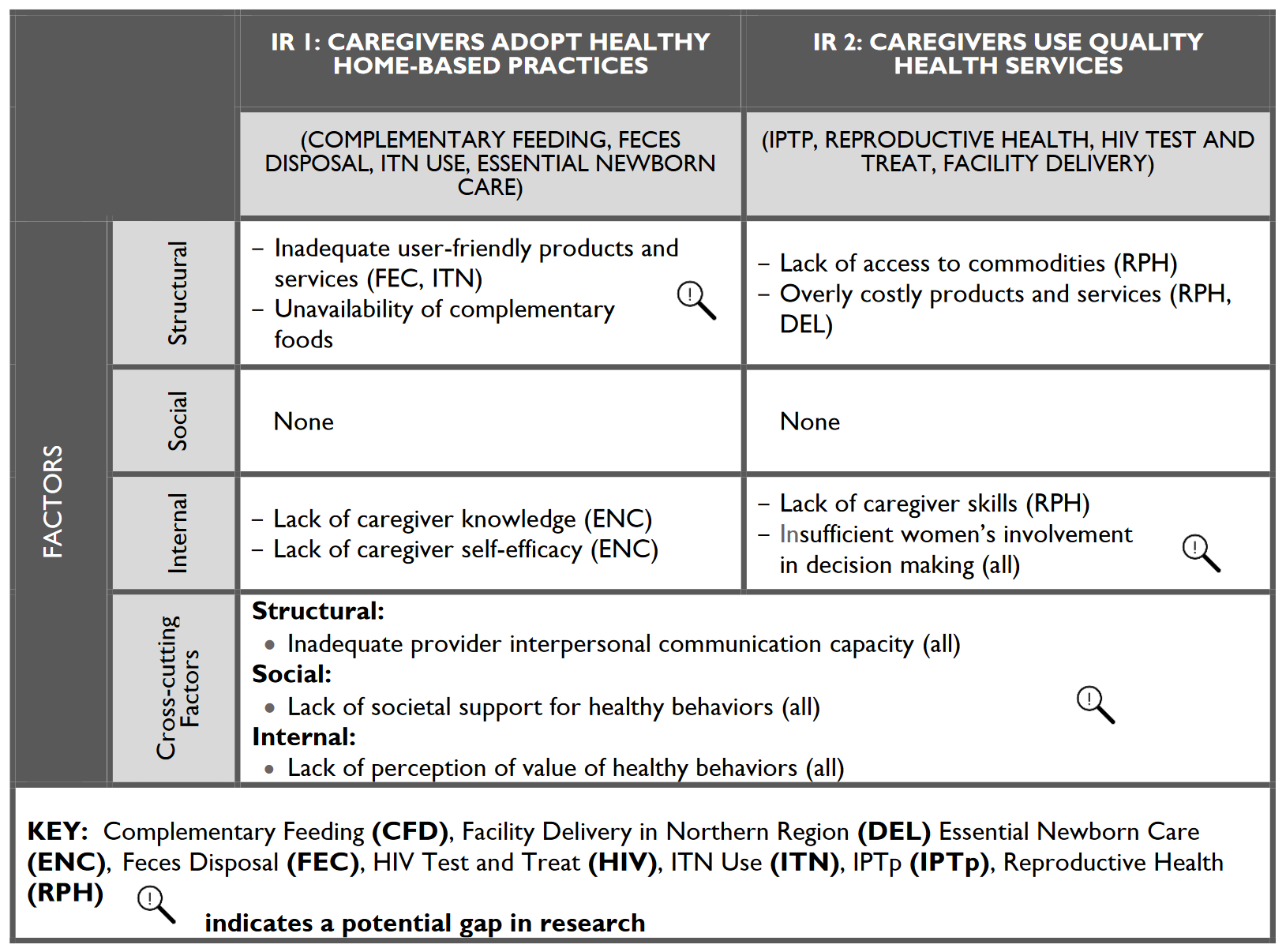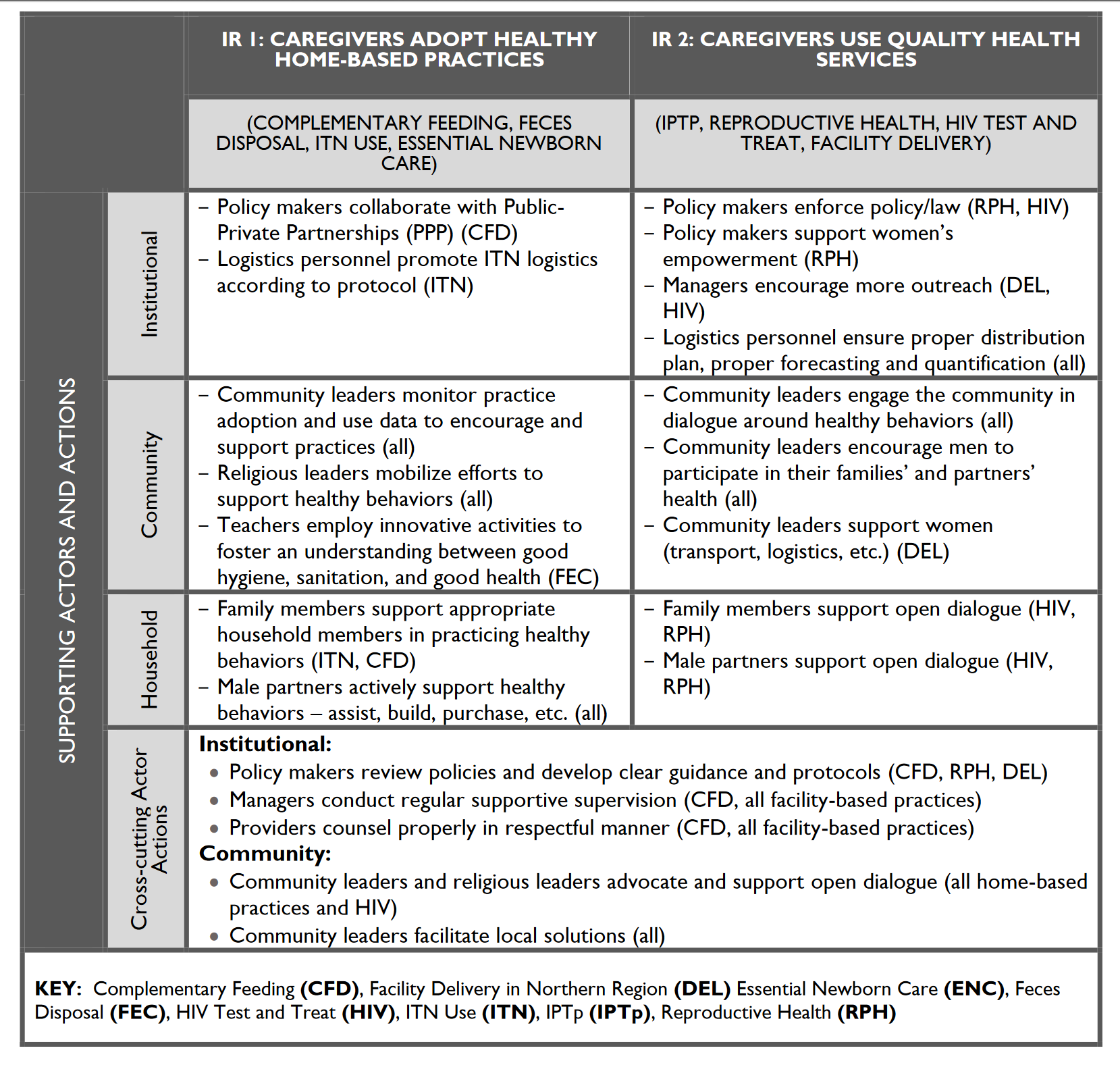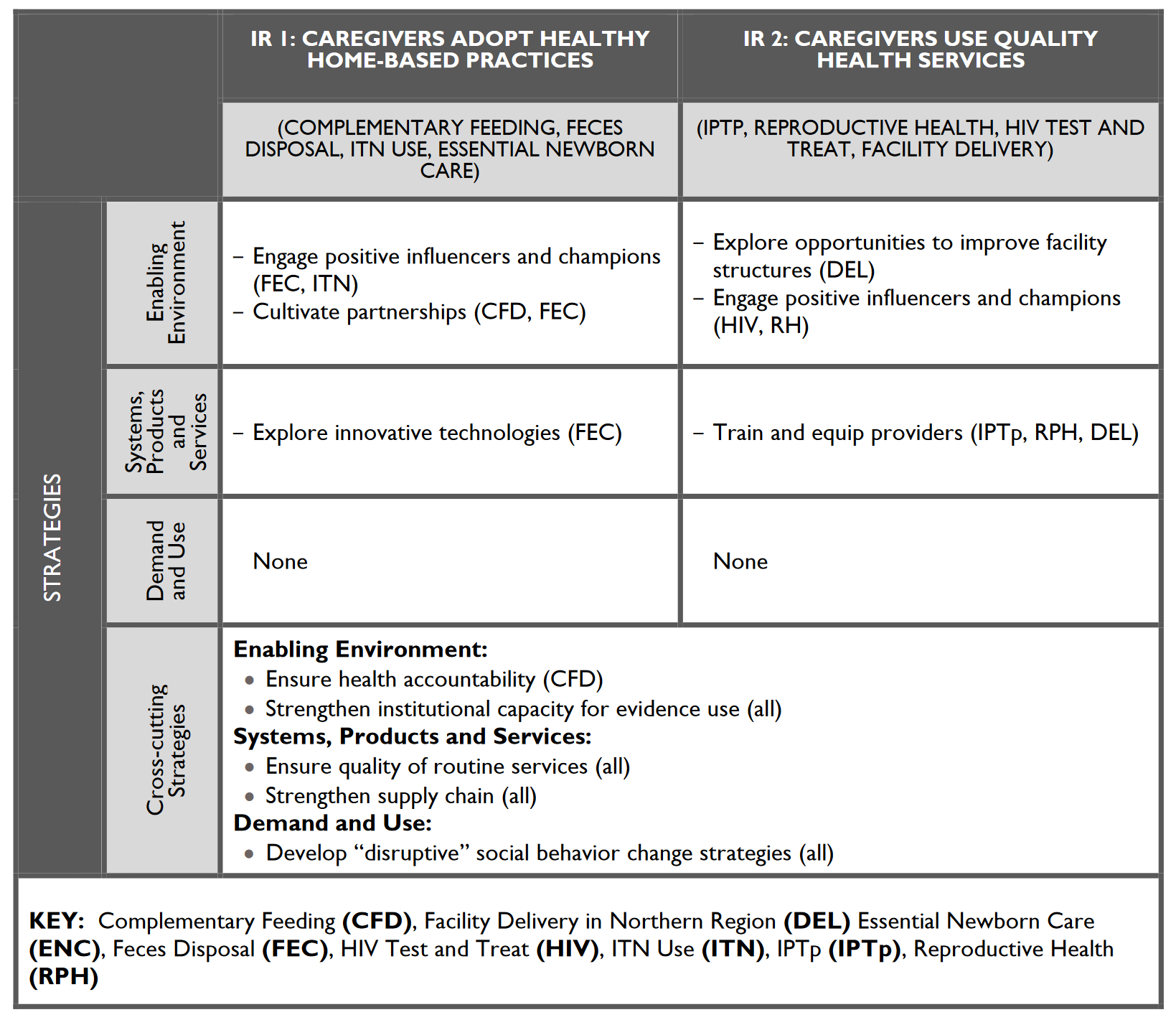- Think | BIG
- INSIGHT
Define pathways to change using behavior analysis.
- ACTION
Influence pathways to change by implementing a behavior-led social and behavior change strategy.
- CHANGE
Track success along pathways to change by measuring behavioral outcomes.
- BIG | Tools
- Resources
Sample language has been drafted to help staff write with a behavioral focus. Click on any of the categories below to find language on that topic. hen cut, paste, and adapt any of the language thatis useful to you.
Maternal and Child Survival Efforts
Development organizations are making strategic investments to accelerate progress towards saving XX children and XXmothers by XXXX. Over 30 priority behaviors have been identified which, evidence suggests, can save lives if they are practiced properly and widely. A premium is being set on behavioral goals, indicators that measure behavior, and programming that closes the gap between current practice and lifesaving practice. [COUNTRY NAME] is a priority country for maternal and child survival efforts.
Priority Behaviors are those that: 1) have the most potential to directly or indirectly reduce the risk of maternal and child death due to a preventable cause; and 2) have low uptake in a particular context. These behaviors are presented from the perspective of the person who must carry out the behavior.
Provided below are examples of Priority Behaviors in seven health areas: Child Health and Immunization, Malaria, Maternal Health, Newborn Health, Nutrition, Reproduction Health, and Water, Sanitation and Hygiene.
Child Health and Immunization
- Caregivers provide appropriate treatment for diarrhea
- Caregivers appropriately manage care for signs and symptoms of pneumonia in children
- Caregivers complete a full course of timely vaccinations for infants and children under 2 years
Malaria
- Caregivers appropriately manage care for signs and symptoms of malaria for children
- Pregnant women take intermittent preventive treatment of malaria (IPTp) during antenatal care (ANC) visit
- Pregnant women and children sleep under an insecticide-treated net (ITN)
Maternal Health
- Pregnant women complete a full course of quality antenatal care (ANC)
- Pregnant women deliver in a health facility with an equipped, qualified provider
Newborn Health
- Caregivers provide essential newborn care immediately after birth
- Caregivers seek prompt and appropriate care for signs and symptoms of newborn illness
Nutrition
- Caregivers feed adequate amounts of nutritious, age-appropriate foods to children from 6 to 24 months of age, while continuing to breastfeed
- Mothers breastfeed exclusively for six months after birth
- Mothers initiate breastfeeding within one hour after delivery
Reproductive Health
- After a live birth, women or their partners use a modern contraceptive method to avoid pregnancy for at least 24 months
- Sexually active adolescents use a modern contraceptive method to delay first birth until after age 18
Water, Sanitation and Hygiene
- Family members safely dispose of human feces
- Family members drink safe water
- Family members wash hands with soap under running water at 4 critical times (after defecation, after changing diapers, before food preparation and before eating)
Analyzing behaviors is the process through which one takes the broad behavior statement (for example, a Priority Behavior) and
- Delineates the steps needed to practice this behavior for an efficacious outcome;
- Segments the audience as determined by the epidemiology and/or behavioral factor analysis (for example, by geography, wealth, education);
- Determines factors that can prevent or support the practice of this behavior;
- Highlights key possible supporting actors and their actions that are needed for the target audience to realize the behavior (for example, health workers for those behaviors are tied to health services, family members for those behaviors that need family approval); and
- Delineates appropriate strategy to involve these supporting actors and leverage or overcome these factors.
Once this analysis has been completed, a logical pathway to change will have been detailed to achieve desired behavioral outcome.
Behavior in a Proposal (General)
Bringing about changes to people's behavior requires an understanding of 1) what they are doing and why and 2) what they might be willing to do and why, and then strategically finding ways to close the gap between the two. While communication is important to addressing both social and behavioral challenges facing individuals and families, other actions such as policies, financing, availability of services and products, and behavior-enabling technologies are often also required to fully resolve the challenges. The successful offeror will propose a framework for achieving the behaviors at the heart of the program. The general framework will be accompanied by an illustration of the kind of strategic programming that can be expected from different levels (household, community, health system, institutional/program) to support individuals and families to overcome specific challenges to the priority behaviors
[PROGRAM NAME] will look beyond the traditional behavior change models to identify multi-disciplinary, multi-pronged approaches to apply. [PROGRAM NAME] will design activities using the state-of-the-art approaches to generate demand for services, while also addressing identified barriers, which may include convenience, reliability, and quality.
A program that defines the key behaviors underlying its development goal and then develops programming to enable caregivers, family members, and others to meet the challenges they face in practicing those behaviors will be more likely to effect positive outcomes and do so sustainably. Offerors will demonstrate how their approach prioritizes reaching priority behavioral outcomes and emphasizing the key considerations and activities in the design, implementation, and monitoring and evaluation phases. This will include, but is not limited to the following, and they should be based on a demonstrated understanding of behavior enabling promising program strategies required to address identified barriers and motivators.
[Writer should now list the priority behavioral outcomes, key considerations, and activities]
[PROGRAM NAME] should utilize an agile social and behavior change approach that breaks the problem down into small manageable activities, accomplishes one, tests it, collects feedback from real-world users, and then adapts the project plan to fit new learnings. When a program uses “an agile approach” from the outset, near-real-time tracking of data becomes very important because the program has committed to testing, learning, and changing course throughout the project lifetime, from the very beginning to the very end.
Indicators and Data Collection
[PROGRAM NAME] will pilot test three new and innovative approaches to social and behavior change, data collection, and [other aspects], evaluating their effectiveness. [PROGRAM NAME] will then determine how, where, and when to take the successful approaches to scale. Based on the results of the pilot tests, [PROGRAM NAME] could, additionally, make provisions to incorporate new and innovative approaches pilot-tested by others into the program.
In line with the program's Collaboration, Learning, and Adapting (CLA) objectives, [PROGRAM NAME] will incorporate behavioral outcome indicators into the monitoring and evaluation framework. Key project success indicators will be tracked in near-real time, throughout the project lifetime, to inform decision-making and ensure that evidence-based course adjustments can be made quickly. To facilitate data sharing with relevant global platforms, [PROGRAM NAME] wil luse standard monitoring tools and platforms to ensure that all quantitative data are collected and reported in ways that are machine-readable, easily understood by and shared with stakeholders, and compatible with the International Aid Transparency Initiative standard (http://iatistandard.org/). To the extent feasible, [PROGRAM NAME] will build monitoring tools on the DHIS2 platform currently used by the Ministry of Health, and, only as needed, adapt or design additional templates.
Addressing One Behavior in a Proposal or Activity
You will need to adapt and revise this language based on the behavior and its analysis (i.e., Behavior Profile or similar). Visit Focus and Analyze resources for more information on how to effectively analyze selected behavior(s).Behavior-centered vs. Behavior-led
Focusing on behaviors allows programs to identify key behaviors driving health outcomes, and to design, implement, track, and adapt programming to change those behaviors for maximally-effective use of investments. Bringing about changes to people's behavior requires an understanding of what they are doing and why,and what they might be willing to do and why—and then strategically closing the gap between the two. Often, systemic elements must be addressed in order to fully resolve the social and behavioral challenges facing individuals and families. These systemic elements might include policy and governance, financing, health systems strengthening, communication, availability of services and products, and behavior-enabling technologies. An effective and comprehensive social and behavior change program, therefore, requires strategic thinking, behavioral guidance, and a systems approach to ensure that the primary beneficiaries can successfully adopt positive behaviors.
Statement on Selected Priority Behavior
This program will focus on the following behavior: Caregivers appropriately manage care for signs and symptoms of malaria for children. It will be measured using the following indicator: Among children under age five with fever in the two weeks preceding the survey, percentage for whom advice or treatment was sought from a health facility or provider. This behavior has been selected as a priority because 21% of deaths of under-fives in our country are due to malaria and, with only 23% uptake of this behavior, it is one of the most important behaviors that we can impact to reduce child mortality.
Research indicates that caregivers do not utilize health facilities when their children have signs and symptoms of malaria because of one or more of nine critical factors: (1) facilities are too far; (2) malaria prevention,diagnosis and treatment supplies are unavailable; (3) they exhaust other local options first; (4) providers do not follow National Malaria Case Management Guidelines; (5) they are poorly treated by providers; (6) health facilities are poorly equipped and maintained; (7) fever is considered normal andaccepted; (8) they feel treatment is unnecessary or ineffective; and (9) they are unaware that promptdiagnosis and treatment can prevent symptoms, complications, and death from malaria. We will carry out interventions that will reduce or leverage these critical factors. Furthermore, we will critically assess and track the impact we are having on overcoming these critical factors.
Statement on Key Supporting Actors and Actions
Previous experience and research indicate that several key supporting actors must be involved in helping to address these factors to achieve the behavior, “Caregivers appropriately manage care for signs and symptoms of malaria for children.” These actors include institutional players (providers, logistics personnel, and managers) and two community actors (community and religious leaders). We will work to intensively involve and include these influencers. Specifically, the types of actions they will carry out to help overcome the barriers and leverage the motivators include:
- Providers diagnose malaria using rapid diagnostic tests (RDTs) for all suspected malaria cases;
- Providers prescribe anti-malarials per the national surveillance guidelines for all positive RDT results;
- During all interactions, providers counsel caregivers on the severity of malaria, importance of diagnosis, treatment, danger signs, and when and where to seek care;
- Logistics personnel procure sufficient stocks of malaria diagnostics and supplies;
- Managers seek innovative ways to provide client-friendly services that are closer to the clients;
- Managers conduct regular supervisory visits to ensure that providers follow approved guidelines and that facilities are properly equipped and maintained;
- Community leaders support social accountability structures to ensure that facilities are properly equipped and maintained and provide quality services; and
- Community and religious leaders emphasize the severity of malaria, importance of seeking care for fever, and efficacy of diagnosis and treatment options.
Statment on Illustrative Strategies or Interventions
Based on the analysis of this Priority Behavior, its steps, its inhibiting factors, and the needed supporting actor actions as found in the desktop research-based Behavior Profile appendix, the following interventions create a direct pathway to increasing the practice of the priority behavior, "Caregivers appropriately manage care for signs and symptoms of malaria for children." We will utilize all research and experience at our disposal to track these pathways to change from our innovative interventions back to the priority behavior. We will demonstrate how these interventions ensure that the pathways are maintained, and that behavior change happens. Interventions include:
- Financing: Establish transportation systems and transport within the communities to ensure access to care
- Supply Chain: Set up effective supply chain and quality control systems in public and private sectors to ensure diagnostic tools and treatment for other febrile illnesses are available
- Quality Improvement: Train providers to adhere to test results, ensure treatment as per national guidelines, and explain the treatment protocol to caregivers
- Quality Improvement: Equip health workers and community health workers with locally tailored, behavior-centered job aids
- Quality Improvement: During pre-service and in-service training, emphasize the importance of respectful quality care by providers to ensure clients receive quality treatment
- Quality Improvement: Develop facilities, equipment, and maintenance checklists for use by managers and providers to improve health care facilities
- Communication: Implement SBCC activities to educate caregivers on malaria symptoms, danger signs, severity, and other important aspects of malaria care and prevention
- Collective Engagement: Conduct community mobilization activities for caregiver and caregiver support systems around malaria care seeking, diagnosis, treatment, and counseling to promote prompt care seeking
Statement on Theory of Change - Results Framework
Our theory of change accounts for and addresses the core elements needed to see the desired behavior change—steps required to practice the behavior, factors that need to be addressed, supporting actors that can assist in influencing these factors, and interventions that can effectively engage the selected supporting actors and overcome or leverage the critical factors. It ensures that a primary actor can overcome the causes inhibiting the achievement of our desired goal and take the necessary steps to adopt the priority behavior. [include a theory of change design here, such as:
Addressing Multiple Behaviors in a Procurement Mechanism
You will need to adapt and revise this language based on the behaviors you have chosen to prioritize and their Summary. Visit Focus and Analyze resources for more information on how to effectively analyze your priority behavior(s).
Behavior-centered vs. Behavior-Led
Focusing on behaviors allows programs to identify key behaviors driving health outcomes, and to design, implement, track, and adapt programming to change those behaviors for maximally-efficient and -effective use of investments. Bringing about changes to people's behavior requires an understanding of what they are doing and why, and what they might be willing to do and why—and then strategically closing the gap between the two. Often, systemic elements must be addressed to fully resolve the social and behavioral challenges facing individuals and families. These systemic elements might include policy and governance, financing, health systems strengthening, communication, availability of services and products, and behavior enabling technologies. An effective and comprehensive social and behavior change program, therefore, requires strategic thinking, behavioral guidance, and a systems approach to ensure that the primary beneficiaries can successfully adopt positive behaviors.
Statement on Behavioral Priorities
Because the scope of this activity is large, it is necessary to focus on behaviors and strategies that will have maximum impact. After a thorough assessment of causes of mortality and morbidity in this country (see tablebelow) –particularly the major ones inhibiting achievementof our goal of "reducing maternal and child mortality", of political realities and a move towards independence, and of feasibility, eight behaviors have been prioritized. It is felt that this package of behaviors will best address the causes and accomplish our goal.
Attention and resources will emphasize accomplishing the targets for behavior change of the eight behaviors chosen as priorities. The eight behaviors are presented here by Intermediate Result.
Statement on Factors - Unique and Cross-Cutting
Research has shown that a set of critical factorshas inhibitedthe adoption of this package of behaviors. These includeboth unique and crosscutting factors (see table below where factors are presented by IR and by behavior). We have examined these factors and identified a potential need for research to fill the gaps in what we know about the factors influencing these behaviors. Our interventions are linked to these factors in that this activity will work to overcome these factors and thus enable our primary actors to adopt the priority behaviors.
Statement on Supporting Actors and their Actions - Unique and Cross-Cutting
Previous experience and research indicate that several key supporting actors will be involved in helping to address these factors to achieve the package of behaviors. These actors include institutional players such as policy makers and logistics personnel; community actors such as community and religious leaders and teachers; and household actors such as family members and male partners. The types of actions they will carry out to help overcome barriers tothe primary actor's practice of the priority behaviors are detailed in table below. As with factors, several supporting actors and their actions cut across multiple priority behaviors. This table demonstrate show we will involve these supporting actors.
Statement on Illustrative Strategies - Unique and Cross-Cutting
Based on the analyses of the priority behaviors, as found in the appended summary of the analyses of our priority behaviors and accompanying detailed behavior analysis of each priority behavior, several interventions (both cross-cutting and unique to individual IRs or behaviors) have been identified that create a direct pathway to change back to the priority behaviors (see table). We have an analysis process that creates pathways to change from the priority behaviorsto our innovative interventions. While carrying out our activities and adjusting elementson an ongoing basis as needed, we will ensure that the pathways are maintained and that changes in behavior happen.
Statement on Theory of Change - Results Framework
Our theory of change accounts for and addresses the core elements needed to see the desired behavior change—steps required to practice the behavior, factors that need to be addressed, supporting actors that can assist in influencing these factors, and interventions that can effectively engage the selected supporting actorsand overcome or leverage the factors. It ensures that a primary actor can take the steps necessary to adopt the priority behavior and thereby overcome the causes inhibiting the achievement of our desired goal.
[include a theory of change design here, such as:
Think | BIG was developed under the ACCELERATE project, which was made possible by the generous support of the American people through the United States Agency for International Development (USAID) and implemented by The Manoff Group, Inc. in association with Howard Delafield International, OneWorld UK, Social Impact, Inc., and Sonjara, Inc. The information on this website does not necessarily represent the views of USAID or the United States Government.

Contact us with questions or comments.





